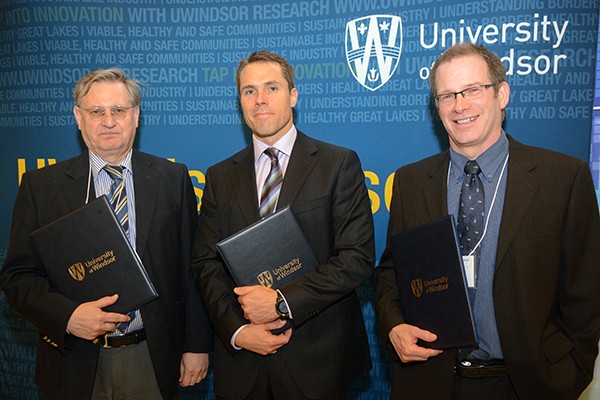 Horst Friedrich of the German Aerospace Center and engineering professors Bill Altenhof of Windsor and Michael Worswick of Waterloo celebrate an agreement to co-operate in research on lightweight vehicle technologies.
Horst Friedrich of the German Aerospace Center and engineering professors Bill Altenhof of Windsor and Michael Worswick of Waterloo celebrate an agreement to co-operate in research on lightweight vehicle technologies.
A new agreement between the University of Windsor, University of Waterloo and Germany’s national centre for transportation research has the potential to save lives and money, says engineering professor Bill Altenhof. He organized the International Crashworthiness Symposium, held Monday in the Centre for Engineering Innovation, which culminated in the Cooperation Agreement on Novel Lightweight Technologies for Improved Crash Safety.
“The focus of the agreement is about collaborating and developing novel ways to dissipate energy in a crash, for the protection of people within vehicles,” Dr. Altenhof said. “We are trying to think outside the box and apply innovative techniques to re-work traditional designs to bring vehicle structural crashworthiness to a new level of performance.”
The three partner institutions will share their complimentary abilities, said Horst Friedrich, director of the Institute of Vehicle Concepts at the German Aerospace Center (known as DLR, the initialism of its German name).
“If you have different talents, different know-how, even different cultures, you find a more fruitful arena to develop new solutions,” he said.
He says that lightweight design is a key technology for reducing energy consumed in transportation.
“This was important in the past, it is important today, and it will become more important in the future,” said Dr. Friedrich. “Of course, safety is obligatory—you cannot sell a car that is not safe.”
Monday’s symposium brought academic and industry experts together to discuss the design of lighter-weight vehicles and innovations that improve fuel efficiency and passenger safety.
“When you are in a severe accident, your life, and many of those close to you, will change forever,” said Altenhof. “With the economic burden of automobile crashes in North America in the billions of dollars per year, any contribution we can make has the potential to save so many lives and millions of dollars.”
